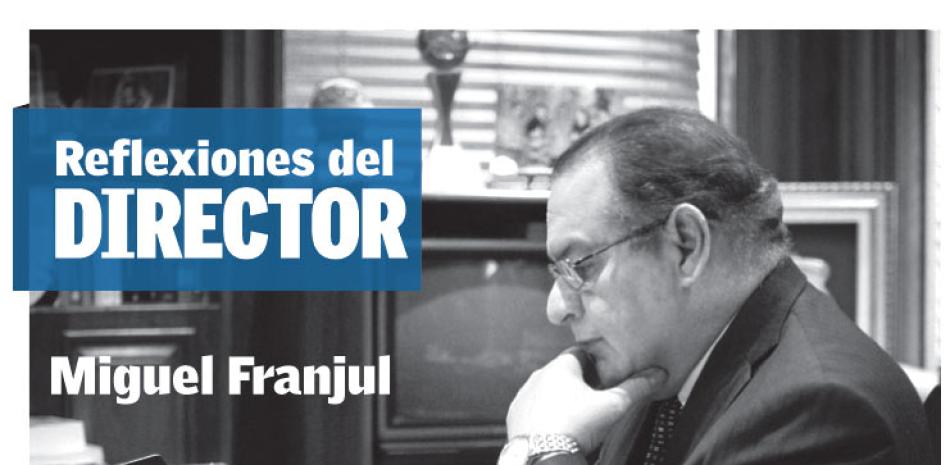REFLEXIONES DEL DIRECTOR
Pensando en digital

Es una realidad innegable que, en estos tiempos, los lectores migran hacia las plataformas digitales para enterarse de los hechos noticiosos, abriendo un terreno fértil al periodismo impreso para alcanzar audiencia y amortiguar la pérdida de ingresos publicitarios con exitosas políticas de suscripción pagada para sus contenidos.
En nuestro caso, el 80 por ciento de los lectores de listindiario.com proviene de usuarios de teléfonos inteligentes. El más reciente registro indica que en enero tuvimos 3 millones de usuarios únicos que produjeron más de 13.2 millones de visitas a nuestra página, rompiendo los récords históricos de LISTÍN DIARIO.
Animados por el fenómeno de las crecientes audiencias digitales, los principales diarios impresos del mundo han aplicado estrategias que combinan el reenfoque de sus contenidos para responder a las expectativas o preferencias de esta masa de lectores con las ofertas de suscripciones pagadas que, en promedio, rondan los 10 dólares al mes.
Los llamados “muros de pago” varían en sus formas. Unos ofrecen como beneficios adicionales menos publicidad en los campos de navegación, libros digitales sobre cocina, salud o innovaciones tecnológicas, acceso privilegiado a los contenidos especiales del impreso como análisis, investigaciones y opiniones de fondo de expertos, avances o proyecciones de películas y novedades musicales, entre otras recompensas.
Hay modalidades de pago para fines de semana solamente, para la semana completa, el mes o el año, algunas veces con descuentos en un periodo de prueba. Un léelo híbrido permite la suscripción de ambas plataformas (impresa y digital), y adelanto de las noticias de mañana a través de correo electrónico.
Naturalmente, todo esto es producto de una reinvención a fondo del modelo tradicional, que consiste en ajustar la planificación y búsqueda de las noticias con las preferencias que muestran los usuarios de redes digitales.
Es decir, “pensando en digital”, sin menoscabar su principal valor: la confiabilidad de sus contenidos, que viene dada por el apego a las reglas de la comprobación de los hechos.
Un ejemplo de esto lo ofrece el periódico The New York Times, de Estados Unidos, que ha logrado más de 4.3 millones de suscriptores digitales y apuesta por alcanzar 10 millones en el 2025, gracias a sus inversiones en tecnología para fortalecer la convergencia de sus plataformas impresas y digital.
Esto le ha permitido mantener ingresos de publicidad y ventas en el orden del 60 por ciento en el impreso, mientras obtiene un 40 por ciento de ellos en suscripciones digitales. La publicidad digital, a su vez, le sigue dando más ingresos que el papel.
Es preciso tener claro que la reinvención, en sí misma, no es simplemente la búsqueda de una mayor monetización de sus plataformas, sino la de mejorar la competitividad del impreso con contenidos de alta calidad, más que las noticias del momento, que circulan instantáneamente por las redes y caducan en poco tiempo.
Traducción al inglés de Las Reflexiones
Thinking digitally
It's an undeniable fact that, these days, readers migrate to the digital platforms to be aware of the news events, leaving a fertile ground for the printed journalism to reach fabulous audiences and cushion the loss of ad revenue by implementing policies of paid subscriptions for their contents.
In our case, 80 percent of the readers of Listindiario.com are smartphone users. The most recent record indicates that in January we had 3 million unique users that produced 13 million visits to our pages, breaking the historical records of the Listin Diario.
Encouraged by the phenomenon of the ever-growing digital audiences, the most popular printed newspapers of the world have applied strategies that combine the re-focus of their contents to respond properly to the expectations of this enormous mass of readers, with the programs of paid subscriptions that, on average, cost around 10 USD per month, per user.
These payment walls vary in their presentations. Some offer, as an additional benefit, the lessening or complete removal of ads on a given platform, some offer digital books about health, cooking recipes or technological innovations, others offer privileged access to the special contents of the printed equivalent, such as extra analysis, researches and the opinions of experts, or even early-access to specific films or musical events, among other rewards. There are payment methods available on weekends only, others throughout the entire week, month or year, sometimes with discounts during a testing period.
Naturally, all this is the product of an in-depth reinvention of traditional models, which now consist on adjusting the planning and organization of the news based on the preferences of the users of the digital platforms.
That's to say, "thinking digitally", without undermining the main asset: the reliability of the contents, which is adhered to the golden rule of thorough verification of the facts.
An example of this is offered by The New York Times, which has so far achieved more than 4.3 million digital subscribers and is committed to reaching at least 10 million by 2025, thanks to its investments in the adequate technology that strengthens the convergence between the printed and digital platforms.
This has allowed them to maintain subscriptions and sales revenues as 60 percent coming from the printed platform, while the other 40 percent comes from their platform. Even though, digital advertising continues to provide more income than their printed advertising.
It's necessary to keep in mind that the reinvention, in itself, is not about the sole search for greater monetization of the platforms, but to also improve the competitiveness of the printed content, by prioritizing higher quality content over the news of the moment or trending news, which circulate instantly through the digital networks and usually expire in a rather short time.


